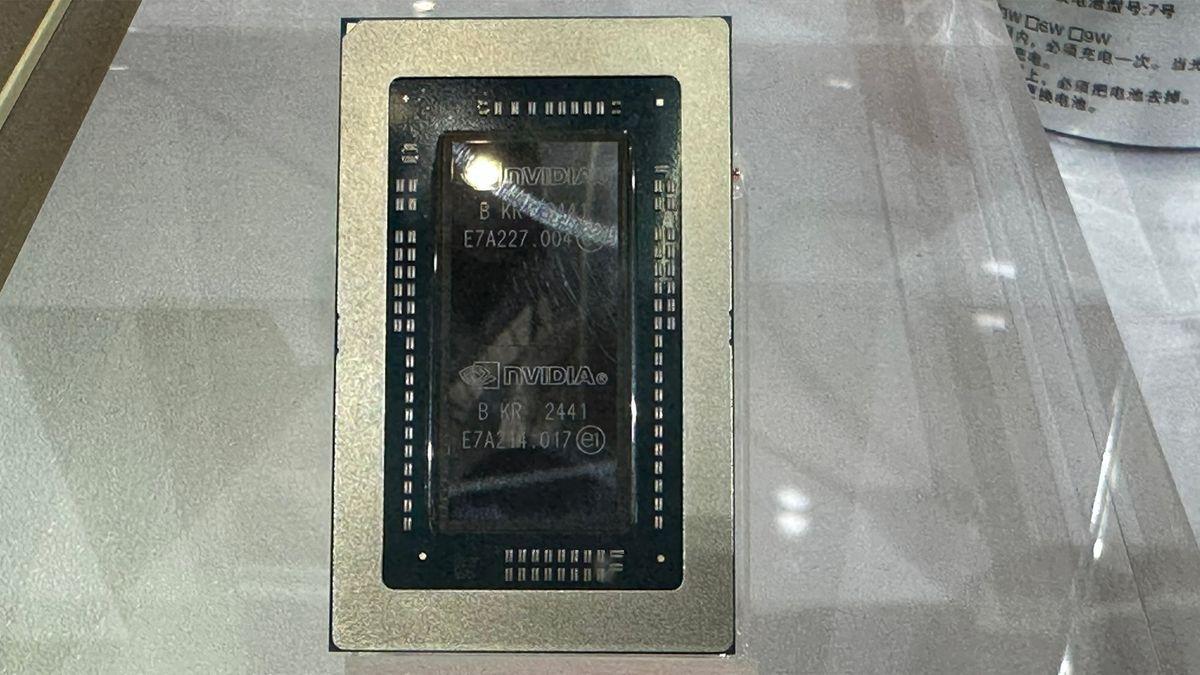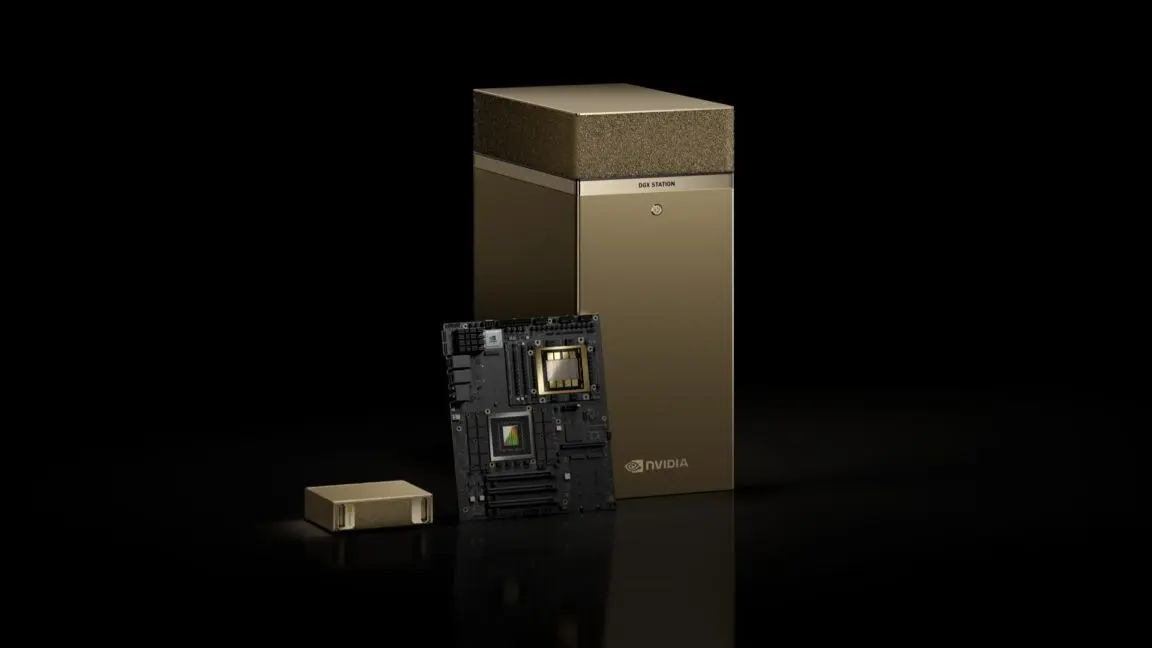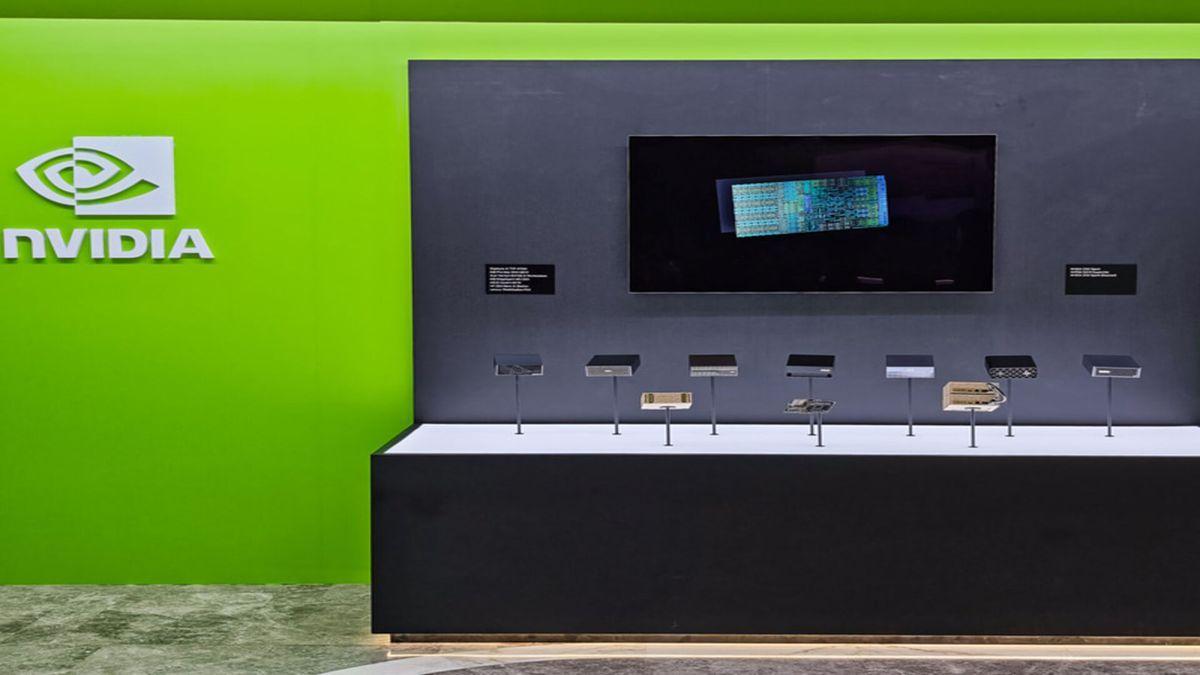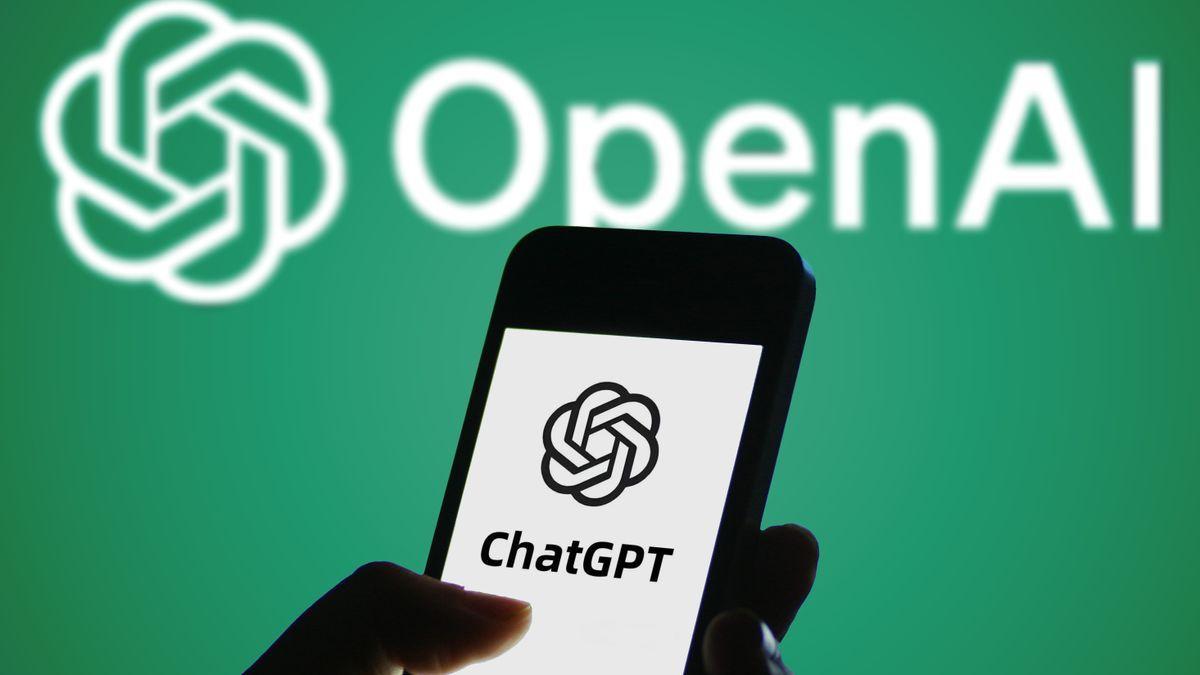ASUS Unveils Ascent GX10: A Compact AI Supercomputer Powered by NVIDIA's GB10 Grace Blackwell Superchip
7 Sources
7 Sources
[1]
Asus' mini supercomputer taps Nvidia Grace Blackwell chip for 1,000 AI TOPS
Asus has lifted the curtains of the Ascent GX10, the company's rendition of Nvidia's Project Digits. Leveraging the chipmaker's GB10 Grace Blackwell Superchip, the Ascent GX10 offers up to 1,000 TOPS of AI performance. Like Project Digits, the Ascent GX10 is a mini-PC that can be placed on your desk. You just need to connect a keyboard, mouse, and monitor to it to have a powerful AI supercomputer at your disposal. Asus hasn't liberated the product page for the Ascent GX10, so all the specifications we have on the mini-PC come from the press release. The GB10, the heart of the Ascent GX10, combines Nvidia's Grace CPU and Blackwell GPU. However, the GB10 is a shrunk-down version of Nvidia's Grace Blackwell Superchip. The Grace CPU features a 20-core Arm design comprising 10 Cortex-X925 and 10 Cortex-A725 cores. It is connected to Nvidia's latest Blackwell GPU through a high-performance NVLink-C2C interconnect. In unison, the GB10 delivers up to 1 PFLOP (1,000 TFLOPS) of FP4 performance. Ascent GX10, Bringing AI Power To Developer's Fingertips "AI is transforming every industry, and the ASUS Ascent GX10 is designed to bring this transformative power to every developer's fingertips," said KuoWei Chao, General Manager of ASUS IoT and NUC Business Group in the press release. "By integrating the NVIDIA Grace Blackwell Superchip, we are providing a powerful yet compact tool that enables developers, data scientists, and AI researchers to innovate and push the boundaries of AI right from their desks." The Ascent GX10 also has 128GB of unified system memory, which allows the device to handle AI models with up to 200 billion parameters. While Asus didn't reveal the memory's specifications, it should use the same LPDDR5x as Project Digits and up to 4TB of M.2 NVMe storage with self-encryption. The device has Nvidia's ConnectX network interface as part of its networking capabilities, meaning you can hook up to Ascend GX10 systems for larger AI models, such as Llama 3.1, which flaunts up to 405 billion parameters. Without a product page or additional renders, we can't know for sure what kind of connectivity the Ascend GX10 will offer. For reference, Project Digits has four USB4 Type-C ports, Wi-Fi, an Ethernet port, and one HDMI 2.1a port for the display. Asus hasn't revealed the Ascent GX10's availability or pricing. Project Digits will hit the market in May, starting at $3,000, and we expect the AScent GX10 to have similar availability and pricing.
[2]
Asus's rival to the DGX Spark has less system storage but costs a third less and looks far smaller than its Nvidia competitor
It's cheaper than Nvidia DGX Spark, with less storage but similar performance AI development is getting ever more demanding, and Asus wants to bring high-performance computing straight to the desks of developers, researchers, and data scientists with the Ascent GX10, a compact AI supercomputer powered by Nvidia's Grace Blackwell GB10 Superchip. Asus's rival to Nvidia's DGX Spark (previously Project Digits) is designed to handle local AI workloads, making it easier to prototype, fine-tune, and run impressively large models without relying entirely on cloud or data center resources. The Ascent GX10 comes with 128GB of unified memory, and the Blackwell GPU with fifth-generation Tensor Cores and FP4 precision support means it can deliver up to 1000 TOPS of AI processing power. It also includes a 20-core Grace Arm CPU, which speeds up data processing and orchestration for AI inferencing and model tuning. Asus says it will allow developers to work with AI models of up to 200 billion parameters without running into major bottlenecks. "AI is transforming every industry, and the Asus Ascent GX10 is designed to bring this transformative power to every developer's fingertips," said KuoWei Chao, General Manager of Asus IoT and NUC Business Group. "By integrating the Nvidia Grace Blackwell Superchip, we are providing a powerful yet compact tool that enables developers, data scientists, and AI researchers to innovate and push the boundaries of AI right from their desks." Asus has built the GX10 with NVLink-C2C, which provides more than five times the bandwidth of PCIe 5.0, allowing the CPU and GPU to share memory efficiently, improving performance across AI workloads. The system also comes with an integrated ConnectX network interface, so two GX10 units can be linked together to handle even larger models, such as Llama 3.1 with 405 billion parameters. Asus says the Ascent GX10 will be available for pre-order in Q2 2025. Pricing details have not yet been confirmed by Asus, but Nvidia says it will cost $2999 and come with 1TB of storage. In comparison, Nvidia's own DGX Spark is a thousand dollars more ($3999) and comes with 4TB of storage.
[3]
Asus Ascent GX10 packs supercomputer power into a tiny box
Asus has introduced the Ascent GX10, a mini supercomputer designed for AI and machine learning workloads. The system is powered by Nvidia's GB10 Grace Blackwell Superchip, making it a notable addition to the AI computing market. The Ascent GX10 features Nvidia's GB10 Grace Blackwell Superchip, which integrates a 20-core Arm-based CPU with a Blackwell GPU. This setup delivers up to 1,000 TOPS (Tera Operations Per Second) of AI performance, making it suitable for edge computing and AI model training. Recommended Videos The system supports 128GB of unified memory, allowing it to run large AI models, including those with up to 200 billion parameters. For more demanding applications, two GX10 units can be connected via Nvidia's ConnectX-7 network interface, enabling support for models with up to 405 billion parameters, such as Meta's Llama 3.1. High-performance AI computing is typically confined to large data centers due to space, power, and cooling needs. The Ascent GX10 offers an alternative by providing a powerful AI system in a compact form factor, allowing researchers and developers to run complex AI workloads without requiring large-scale infrastructure. Get your weekly teardown of the tech behind PC gaming ReSpec Subscribe Check your inbox! Privacy Policy By integrating the Nvidia Grace Blackwell Superchip, we are providing a powerful yet compact tool that enables developers, data scientists, and AI researchers to innovate and push the boundaries of AI right from their desks," said KuoWei Chao, General Manager of Asus IoT and NUC Business Group in a press note. The GX10 can function as a standalone workstation or integrate into private cloud environments, making it adaptable for AI startups, research institutions, and businesses developing AI models. Asus has not yet announced pricing or availability for the Ascent GX10. However, it is expected to be comparable to Nvidia's Project Digits, a similar compact AI workstation that the chipmaker announced earlier this year priced at $3,000. Like the GX10, Project Digits is designed to bring high-performance AI computing to smaller-scale environments, suggesting that Asus' system may enter the market around the same time. With its compact design and AI processing capabilities, the Ascent GX10 presents a viable alternative for professionals needing local AI computing power without reliance on cloud-based solutions.
[4]
ASUS Ascent GX10 AI miniPC with NVIDIA GB10 Grace Blackwell superchip
The ASUS Ascent GX10 AI supercomputer is built to help gurus develop and test AI models locally with a system that can also scale when needed. It works either as a standalone desktop system or as part of a private cloud setup. By connecting multiple GX10 units using integrated NVIDIA ConnectX network cards, it's possible to handle very large AI models - up to 405 billion parameters when two systems are combined. This design makes it easier for gurus to prototype, optimize, and run inferencing tasks without having to use shared computing clusters for every experiment. Additionally, the system supports NVIDIA AI Software, which lets you move models from the desktop environment to cloud setups with little to no changes in your code. At the heart of the ASUS Ascent GX10 is the NVIDIA GB10 Grace Blackwell superchip, which combines a powerful Blackwell GPU with a 20-core Arm CPU. This combination helps accelerate AI tasks by providing up to 128 GB of unified memory for data-intensive operations. The superchip comes with fifth-generation Tensor Cores and support for FP4, enabling it to deliver up to 1,000 TOPS of AI computing power. It also uses NVIDIA NVLink-C2C to create a coherent memory model that outperforms the traditional PCIe 5.0 standard. These features ensure that even real-time inferencing and large-scale model tuning can be handled efficiently in a compact package.
[5]
ASUS Ascent GX10 Mini-PC: powerful AI supercomputer with NVIDIA GB10 Grace Blackwell Superchip
TL;DR: ASUS has launched the Ascent GX10, a compact AI supercomputer featuring NVIDIA's GB10 Grace Blackwell Superchip. It offers up to 1000 TOPS of AI performance and 128GB of unified memory, enabling advanced AI model development. The device includes a 20-core Arm CPU and supports seamless integration with other systems. ASUS has just introduced its new Ascent GX10, its new groundbreaking AI supercomputer, powered by NVIDIA's new GB10 Grace Blackwell Superchip. An AI supercomputer, on your desk, and it can almost fit into the palm of your hand.... check it out: ASUS's new Ascent GX10 places an incredible amount of AI power at your fingertips, and directly onto the desks of developers, AI researchers, and data centers across the planet. The new ASUS Ascent GX10 delivers up to 1000 TOPS of AI performance, with 128GB of unified system memory, developers can experiment, fine-tune or inference the latest generation of reasoning AI models with up to 200 billion parameters. Inside, the new ASUS Ascent GX10 AI supercomputer features NVIDIA's new Grace Blackwell Superchip, designed with the Grace Blackwell architecture, and optimized for the compact-size form factor. The new NVIDIA GB10 chip includes a Blackwell GPU with 5th Gen Tensor Cores and FP4 support, with up to 1000 TOPS of AI processing power There's also a high-performance NVIDIA Grace CPU with a 20-core Arm processor that enhances data pre-processing and orchestrated, accelerating the tuning of models and real-time inferencing. NVIDIA's new GB10 Superchip uses NVIDIA NVLink-C2C to provide cohesive CPU + GPU memory models with 5x the bandwidth of PCIe Gen5. KuoWei Chao, General Manager of ASUS IoT and NUC Business Group said: "AI is transforming every industry, and the ASUS Ascent GX10 is designed to bring this transformative power to every developer's fingertips. By integrating the NVIDIA Grace Blackwell Superchip, we are providing a powerful yet compact tool that enables developers, data scientists, and AI researchers to innovate and push the boundaries of AI right from their desks".
[6]
ASUS Shows Off Ascent GX10, An AI Supercomputer With NVIDIA GB10 At Its Core To Handle Intensive AI Models On Budget
ASUS brings a compact AI supercomputer that can deliver up to 1000 AI TOPs of FP4 precision through NVIDIA's high-performance GB10. ASUS Reveals Ascent GX10 Mini Supercomputer, a Powerful System with 128 GB of Unified Memory, Ready to Train AI Models While everyone's eyes are on NVIDIA's GB300 platform, its GB10 is fairly powerful and far more affordable than the former. This led ASUS to build a mini supercomputer called "Ascent GX10" that uses the GB10 and can still train and perform quite intensive operations. While major hardware manufacturers showcased their leading hardware at the GTC event, ASUS also came up with the Ascent GX10 AI Supercomputer, featuring the GB10 Grace Blackwell Superchip and a 20-core Arm CPU. With such a powerful CPU-GPU combo, the Ascent GX10 supercomputer is ready to deliver up to 1,000 AI TOPs (Tera operations per Second) of processor power that can handle large AI workloads. In contrast, the GB300 platform can deliver 20 times higher AI TOPs (20,000) but is aimed at very intensive AI workloads. The Ascent GX10 focuses more on the budget segment, offering developers an affordable solution to train their AI models. The Ascent GX10 is shipped with 128 GB of coherent unified system memory and can help in the development, experimentation, and inference of AI models with up to 200 billion parameters. Since the system is based on the NVIDIA GB10 platform, it features the fifth-gen Tensor cores and FP4 support as well. The FP4 support helps the hardware to offer faster computation and NVIDIA's Blackwell GPUs excel at it, especially when it comes to lower memory utilization. ASUS Ascent GX10 is aimed at offering an economical solution for aI development and, as per KuoWei Chao, the General Manager of ASUS IoT and NUC Business Group, AI is transforming every industry, and the ASUS Ascent GX10 is designed to bring this transformative power to every developer's fingertips, By integrating the NVIDIA Grace Blackwell Superchip, we are providing a powerful yet compact tool that enables developers, data scientists, and AI researchers to innovate and push the boundaries of AI right from their desks. Ascent GX10 also supports high-speed connectivity through the integration of NVIDIA NVLink-C2C, which offers a cohesive CPU-GPU memory model with the ability to offer 5x the bandwidth of PCI-E 5.0. Moreover, developers can interconnect two GX10 supercomputers via the NVIDIA ConnectX-7 network interface cards and the system will be ready to handle models with up to twice the parameters (roughly 405b) like the Meta Llama 3.1. There is no word on the pricing at the moment, but ASUS will start taking pre-orders in the second quarter of 2025.
[7]
ASUS Unveils Ascent GX10 AI Supercomputer Powered by NVIDIA GB10 Superchip
Central to the new ASUS Ascent GX10 is the advanced NVIDIA GB10 Superchip, designed with the Grace Blackwell architecture and optimized for compact-size form factor. The enormously-powerful GB10 chip includes a robust Blackwell GPU with fifth-generation Tensor Cores and FP4 support, delivering up to 1000 TOPS of AI processing power. Additionally, it features a high-performance Grace 20-core Arm CPU that enhances data preprocessing and orchestration, accelerating the tuning of models and real-time inferencing. The GB10 Superchip employs NVIDIA NVLink-C2C to provide a cohesive CPU+GPU memory model with five times the bandwidth of PCIe 5.0.
Share
Share
Copy Link
ASUS introduces the Ascent GX10, a mini AI supercomputer featuring NVIDIA's GB10 Grace Blackwell Superchip, offering 1,000 TOPS of AI performance in a compact form factor for developers and researchers.

ASUS Introduces Powerful Mini AI Supercomputer
ASUS has unveiled the Ascent GX10, a compact AI supercomputer that brings unprecedented processing power to developers' desktops. This innovative device, powered by NVIDIA's GB10 Grace Blackwell Superchip, represents a significant advancement in accessible AI computing technology
1
.Cutting-Edge Hardware Specifications
The Ascent GX10 boasts impressive specifications:
- NVIDIA GB10 Grace Blackwell Superchip
- Up to 1,000 TOPS (Tera Operations Per Second) of AI performance
- 20-core Arm-based CPU (10 Cortex-X925 and 10 Cortex-A725 cores)
- 128GB of unified system memory
- Support for AI models with up to 200 billion parameters
- Up to 1TB of M.2 NVMe storage
2
Advanced Connectivity and Scalability
The Ascent GX10 incorporates cutting-edge connectivity features:
- NVIDIA NVLink-C2C interconnect, providing 5x the bandwidth of PCIe 5.0
- NVIDIA ConnectX network interface for linking multiple units
- Ability to handle larger AI models (up to 405 billion parameters) when two systems are combined
3
Versatility in AI Development
The Ascent GX10 is designed to cater to various AI development needs:
- Functions as a standalone workstation or integrates into private cloud environments
- Supports NVIDIA AI Software for seamless model transition between desktop and cloud setups
- Enables local prototyping, optimization, and inferencing tasks without relying on shared computing clusters
4
Related Stories
Market Positioning and Availability
ASUS positions the Ascent GX10 as a competitor to NVIDIA's DGX Spark:
- Expected price point of $2,999, which is $1,000 less than the DGX Spark
- Smaller form factor compared to the NVIDIA offering
- Scheduled for pre-order availability in Q2 2025
5
Impact on AI Development Landscape
The introduction of the ASUS Ascent GX10 marks a significant shift in AI computing accessibility:
- Brings high-performance AI capabilities to individual desktops
- Enables developers, data scientists, and researchers to work on complex AI models locally
- Reduces reliance on cloud-based solutions for AI development
- Potentially accelerates AI innovation across various industries
KuoWei Chao, General Manager of ASUS IoT and NUC Business Group, emphasized the transformative potential of the Ascent GX10: "AI is transforming every industry, and the ASUS Ascent GX10 is designed to bring this transformative power to every developer's fingertips."
1
References
Summarized by
Navi
[3]
Related Stories
NVIDIA Enters Desktop AI Market with GB10 Grace Blackwell Chip, ASUS Leads Launch
06 Jul 2025•Technology

ASUS Unveils ExpertCenter Pro ET900N G3: A Desktop Powerhouse with NVIDIA's GB300 Blackwell Ultra Superchip
22 Jul 2025•Technology

Nvidia Unveils DGX Spark and DGX Station: Personal AI Supercomputers for the Desktop
19 Mar 2025•Technology








